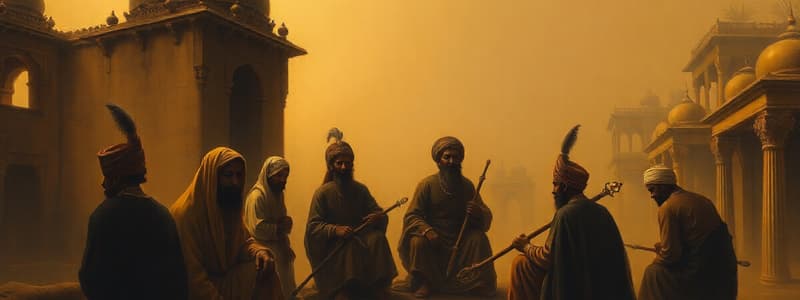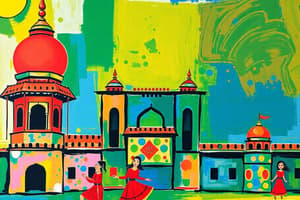Podcast
Questions and Answers
What was the significance of Iltutmish's decision to make Delhi the capital instead of Lahore?
What was the significance of Iltutmish's decision to make Delhi the capital instead of Lahore?
It solidified Delhi's position as the center of power and administration for the Delhi Sultanate.
How did Balban deal with threats to the stability of his rule, both internal and external?
How did Balban deal with threats to the stability of his rule, both internal and external?
He created a strong, centralized army and appointed spies. He also broke the power of Chalisa.
Explain the importance of the 'Iqta System' introduced by Iltutmish.
Explain the importance of the 'Iqta System' introduced by Iltutmish.
It was a system of land assignment for civil administration and army, which led to a centrally paid and recruited army.
What was the 'Chalisa', and who was responsible for dismantling its power?
What was the 'Chalisa', and who was responsible for dismantling its power?
How did Aibak demonstrate his generosity, according to the text?
How did Aibak demonstrate his generosity, according to the text?
What were the names of the silver and copper coins introduced by Iltutmish?
What were the names of the silver and copper coins introduced by Iltutmish?
How did Balban use Persian court models to influence his rule?
How did Balban use Persian court models to influence his rule?
Describe Razia Sultana's rise to power, including the initial challenge to her succession.
Describe Razia Sultana's rise to power, including the initial challenge to her succession.
How did Iltutmish's refusal to shelter Khwarizm Shah impact the Delhi Sultanate?
How did Iltutmish's refusal to shelter Khwarizm Shah impact the Delhi Sultanate?
What were the two mosques that Aibak constructed?
What were the two mosques that Aibak constructed?
What are the five dynasties that make up the Delhi Sultanate?
What are the five dynasties that make up the Delhi Sultanate?
What led to the end of the Slave Dynasty?
What led to the end of the Slave Dynasty?
Name two writers patronized by Qutubuddin Aibak.
Name two writers patronized by Qutubuddin Aibak.
What military department did Balban establish, and what was its purpose?
What military department did Balban establish, and what was its purpose?
What two forms of monarchal salutation did Balban introduce?
What two forms of monarchal salutation did Balban introduce?
What circumstances led to Balban overlooking Sultanate affairs during his last days?
What circumstances led to Balban overlooking Sultanate affairs during his last days?
What was Razia's biggest challenge as a ruler?
What was Razia's biggest challenge as a ruler?
After Razia, which son of Iltutmish was put on the throne by the turkish council Chalisa?
After Razia, which son of Iltutmish was put on the throne by the turkish council Chalisa?
Why was Nasiruddin Mahamud known as the Darvesi King?
Why was Nasiruddin Mahamud known as the Darvesi King?
What contribution toward construction can both Aibak and Iltutmish be credited with?
What contribution toward construction can both Aibak and Iltutmish be credited with?
Flashcards
Delhi Sultanate
Delhi Sultanate
The period from 1206-1526 AD, when Mohammed Ghori's conquests shaped a new political entity in India.
Qutubuddin Aibak
Qutubuddin Aibak
A Turkish slave who became Governor, founded the Slave Dynasty in 1206, and was known as 'giver of Lakhs'.
Quwat-ul-Islam & Adhai din ka Jhonpra
Quwat-ul-Islam & Adhai din ka Jhonpra
Two mosques constructed by Aibak.
Shamsuddin Iltutmish
Shamsuddin Iltutmish
Signup and view all the flashcards
Iltutmish's reforms
Iltutmish's reforms
Signup and view all the flashcards
Chahalgani/Chalisa
Chahalgani/Chalisa
Signup and view all the flashcards
Razia Sultana
Razia Sultana
Signup and view all the flashcards
Chalisa
Chalisa
Signup and view all the flashcards
Diwan-i-Arz
Diwan-i-Arz
Signup and view all the flashcards
Sijda & Paibos
Sijda & Paibos
Signup and view all the flashcards
Study Notes
- The Delhi Sultanate existed from 1206-1526 AD.
- Mohammed Ghori's conquests marked the beginning of the Delhi Sultanate, a new political entity in India.
- The Delhi Sultanate period is divided into 5 dynasties.
- The Slave Dynasty (1206-1290)
- The Khilji Dynasty (1290-1320)
- The Tughlaq Dynasty (1320-1414)
- The Sayyid Dynasty (1414-1451)
- The Lodhi Dynasty (1451-1526)
The Slave Dynasty: 1206-1290 AD
- Qutubuddin Aibak ruled from 1206-1210.
- Aibak was a Turkish slave purchased by Mohammad Ghori, who appointed him as governor.
- After Ghori's death, Aibak became the master of Hindustan and founded the Slave Dynasty in 1206.
- He was known as Lakh Bakhsh (giver of Lakhs) for his generosity.
- Aibak died in 1210 playing Chaugan or Polo.
- He built two mosques: Quwat-ul-Islam at Delhi and Adhai din ka Jhonpra at Ajmer.
- Aibak began construction of Qutub Minar in honor of Khwaja Qutubuddin Bakhtiyar Kaki.
- Aibak supported scholars such as Hasan-un-Nizami (author of 'Taj-ul-Massir') and Fakhruddin (author of 'Tarikh-i-Mubarak Shahi').
Shamsuddin Iltutmish: 1211-1236
- Iltutmish, a slave of Qutubuddin Aibak, took the Delhi throne in 1211 after removing Aram Bakhsh.
- He is considered the "real founder" of the Delhi Sultanate.
- Iltutmish moved the capital from Lahore to Delhi.
- He protected the Delhi Sultanate from Chengiz Khan by refusing refuge to Khwarizm Shah.
- Iltutmish introduced the silver coin (tanka) and the copper coin (jital).
- He organized the Iqta system and reformed the civil administration and army.
- He created an official nobility of slaves known as Chahalgani/Chalisa (group of 40).
- Iltutmish finished the construction of Qutub Minar, which was started by Aibak.
- He supported Minhaj-us-Siraj, the author of "Tabaqat-i-Nasiri."
Ruknuddin: 1236
- Ruknuddin was Iltutmish's son and was put on the throne by his mother, Shah Turkan.
- He was overthrown by Razia, Iltutmish's daughter, while away from the capital dealing with a rebellion in Avadh.
Razia Sultana: 1236-1240
- Although Iltutmish nominated Razia as his successor, nobles initially placed Ruknuddin Firoj on the throne.
- Razia removed Ruknuddin and became the ruler.
- She was the first and only Muslim woman to rule India.
- Razia was popular among the people but faced opposition from nobles and theologians.
- Her preference for the Abyssinian slave Yakut further angered the nobles.
- Governors of Multan, Badaun, Hansi, and Lahore revolted following her accession.
- A major rebellion occurred in Bhatinda, led by Altunia, who refused to recognize Razia's rule.
- Razia, accompanied by Yakut, marched against Altunia.
- Altunia had Yakut murdered and imprisoned Razia.
- Razia then married Altunia, and together they marched towards Delhi.
- In 1240 AD, Razia was assassinated near Kaithal (Haryana).
Bahram Shah: 1240-1242
- After Razia, Bahram Shah, Iltutmish's third son, was placed on the throne by the Turkish council Chalisa.
- He was considered a de jure ruler, with Naib-e-mamlakat (the regent) as the de facto ruler.
- Bahram Shah lost his life after failing to assert his authority on the throne.
Masud Shah: 1242-1246
- Masud Shah, Ruknuddin's son, was deposed after Balban and Nasiruddin Mahamud's mother, Malika-e-Jahan, conspired against him and established Nasiruddin Mahamud as the new Sultan.
Nasiruddin Mahamud: 1246-1266
- He was Iltutmish's son, known as the Darvesi King because of his piety and nobility.
- He died in 1266.
Ghiyasuddin Balban: 1266-1287
- Balban ascended the throne in 1266.
- He broke the power of Chalisa and restored the prestige of the crown.
- This was Balban's greatest contribution towards the stability of the Sultanate.
- Balban appointed spies to stay well-informed.
- He formed a strong centralized army to deal with internal disturbances and to check the Mongols.
- He established the military department Diwan-i-Arz.
- Balban's conception of kingship was influenced by the Persian court model.
- He took the title of Zil-i-Ilahi (Shadow of God).
- Balban introduced Sijda (prostration before the monarch) and Paibos (kissing the feet of the monarch) as normal forms of salutation.
- He destroyed the Mewati Rajputa brigandage in the doab, where forests were cut and forts built.
- In his last days, he overlooked the Sultanate affairs because of the death of his eldest and most loving son, Muhammad, and a rebellion by his closest and most loved slave, Tughril.
- Muhammad died fighting the Mongolians in 1285, while Tughril was captured and beheaded.
Kaiqubad: 1287-1290
- Kaiqubad, a grandson of Balban, was placed on the throne by Fakruddin.
- Fakruddin, the Kotwal of Delhi, assumed high political authority during the last days of Balban.
- Kaiqubad was killed by the Khiliji family, which ended the Slave dynasty and began the Khiliji dynasty at the Delhi throne.
Studying That Suits You
Use AI to generate personalized quizzes and flashcards to suit your learning preferences.




